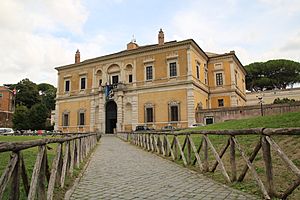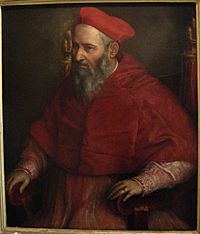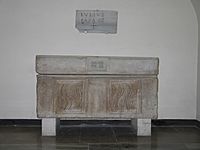Pope Julius III facts for kids
Quick facts for kids Pope Julius III |
|
|---|---|
| Bishop of Rome | |

Portrait by the circle of Girolamo Siciolante, c. 1550 (oil on canvas, 106 x 86 cm; Rijksmuseum)
|
|
| Church | Catholic Church |
| Papacy began | 7 February 1550 |
| Papacy ended | 23 March 1555 |
| Predecessor | Paul III |
| Successor | Marcellus II |
| Orders | |
| Consecration | 12 November 1514 by Antonio Maria Ciocchi del Monte |
| Created Cardinal | 22 December 1536 |
| Personal details | |
| Birth name | Giovanni Maria Ciocchi del Monte |
| Born | 10 September 1487 Monte San Savino, Tuscany |
| Died | 23 March 1555 (aged 67) Rome, Lazio, Papal States |
| Previous post |
|
| Coat of arms | |
| Other Popes named Julius | |
| Papal styles of Pope Julius III |
|
|---|---|
 |
|
| Reference style | His Holiness |
| Spoken style | Your Holiness |
| Religious style | Holy Father |
| Posthumous style | None |
Pope Julius III (born Giovanni Maria Ciocchi del Monte) was the leader of the Catholic Church and the ruler of the Papal States from February 7, 1550, until his death in March 1555. He was born on September 10, 1487, and passed away on March 23, 1555.
Before becoming Pope, he was known as a skilled diplomat. He was chosen as Pope because different groups of cardinals could not agree on another candidate. As Pope, he tried to make some changes to the Church, but these efforts were not very successful or long-lasting. He often preferred to enjoy his personal life.
Contents
Early Life and Career
Giovanni Maria Ciocchi del Monte was born in Monte San Savino. His father was a well-known lawyer in Rome. Giovanni was taught by Raffaele Brandolini Lippo and later studied law at Perugia and Siena. He became known as an expert in canon law (church law) rather than a theologian (someone who studies religion).
Giovanni's uncle, Antonio Maria Ciocchi del Monte, was the Archbishop of Manfredonia. In 1511, his uncle became a Cardinal, and Giovanni took over as Archbishop of Manfredonia in 1513. In 1520, he also became the Bishop of Pavia. People liked him because he was friendly and good at managing things. He served as Prefect of Rome twice and was given many tasks by the Pope's helpers (the papal curia).
During the Sack of Rome (1527), when Rome was attacked, he was one of the people held hostage by the Emperor's soldiers. He barely escaped being executed. Later, Pope Paul III made him a Cardinal in 1536. He was given important missions, including being the first president of the Council of Trent in 1545.
Becoming Pope
How He Was Chosen
When Pope Paul III died in November 1549, the cardinals met to choose a new Pope. This meeting is called a conclave. The 48 cardinals were split into three main groups. One group wanted the Council of Trent to start again. Another group wanted it to stop. A third group supported the family of the previous Pope, Paul III.
Neither the French nor the German groups wanted Giovanni del Monte to be Pope. The Emperor had even said he was not an acceptable choice. However, the French group was able to stop the other two groups from choosing their candidates. This allowed Giovanni del Monte to suggest himself as a candidate that everyone could agree on. He was elected Pope on February 7, 1550.
After his election, he confirmed that Ottavio Farnese, whose support was important for the election, would remain the Duke of Parma. However, when Farnese asked France for help against the Emperor, Julius III sided with the Emperor. He declared that Farnese had lost his title and sent troops to help capture Parma.
Church Changes
At the beginning of his time as Pope, Julius III truly wanted to make changes to the Catholic Church and restart the Council of Trent. However, not much was achieved during his five years in office. In 1551, at the request of Emperor Charles V, he agreed to reopen the Council of Trent. He also joined a group against the Duke of Parma and Henry II of France, which led to the War of Parma. But Julius soon made peace with the Duke and France, and in 1553, he stopped the Council meetings again.
The King of France, Henry II, had threatened to stop recognizing the Pope if the new Pope seemed to favor the Habsburg family. When Julius III restarted the Council of Trent, Henry prevented French bishops from attending and did not follow the Pope's rules in France. Even after Julius III stopped the Council again, Henry continued to pressure the Pope to side with him against the Habsburgs.
Julius III began to focus more on Italian politics. He spent a lot of time at his beautiful palace, the Villa Giulia, which he had built for himself near Rome. From there, he lived comfortably, sometimes making small efforts to improve the Church by trying to restart groups focused on reform. He was a friend of the Jesuits, a religious order, and officially supported them again in 1550. In 1552, he founded the Collegium Germanicum, a college for German students, and gave it money each year.
During his time as Pope, the Catholic faith returned to England under Queen Mary in 1553. Julius sent Cardinal Reginald Pole as a special representative with the power to make decisions to help this happen. In February 1555, a messenger from the English Parliament was sent to Julius to tell him that England was officially rejoining the Catholic Church. However, the Pope died before the messenger reached Rome.
Shortly before his death, Julius sent Cardinal Giovanni Morone to represent the Church at the Peace of Augsburg talks. He may have been less active during his last three years as Pope because he suffered from frequent and painful attacks of gout.
Art and Buildings
Some people at the time were worried that the Pope was not very interested in political or church matters. When his efforts to change the Church did not work well, Julius III focused instead on art and building projects, especially his grand Villa Giulia. He spent most of his time, and a lot of the Church's money, on parties and fun at the Villa Giulia. This villa was designed for him by Vignola. Bartolomeo Ammannati designed many parts of the garden, with help from Giorgio Vasari, the Pope himself, and Michelangelo. Today, the Villa Giulia is home to the National Etruscan Museum, which has a collection of ancient Etruscan art.
Even more important was his support for the famous Renaissance composer Giovanni Pierluigi da Palestrina. Julius brought him to Rome to be his music director.
Other Activities
New Cardinals
During his time as Pope, Julius III appointed twenty new cardinals in four different ceremonies. This included one cardinal whose name he kept secret in 1551 and revealed the next year.
Beatifications
While he did not declare any new saints during his papacy, Julius III did beatify Silvester of Troina. Beatification is a step before becoming a saint.
Death
Julius III passed away at 7:00 PM on March 23, 1555. In his later years, he suffered from gout, which he tried to cure by fasting. He died because of stomach problems. As he was dying, he had trouble swallowing and ate very little because it was uncomfortable. After his death, it was thought that the Pope might have died from stomach or esophageal cancer.
In Stories
In the book Q by Luther Blissett, Julius appears near the end of the story. He is shown as a cardinal who believes in religious tolerance during the big changes of the 16th century, like the Reformation. His election as Pope and the start of the Inquisition (a church court) form the last parts of the novel.
See also
 In Spanish: Julio III para niños
In Spanish: Julio III para niños
- Cardinals created by Julius III




